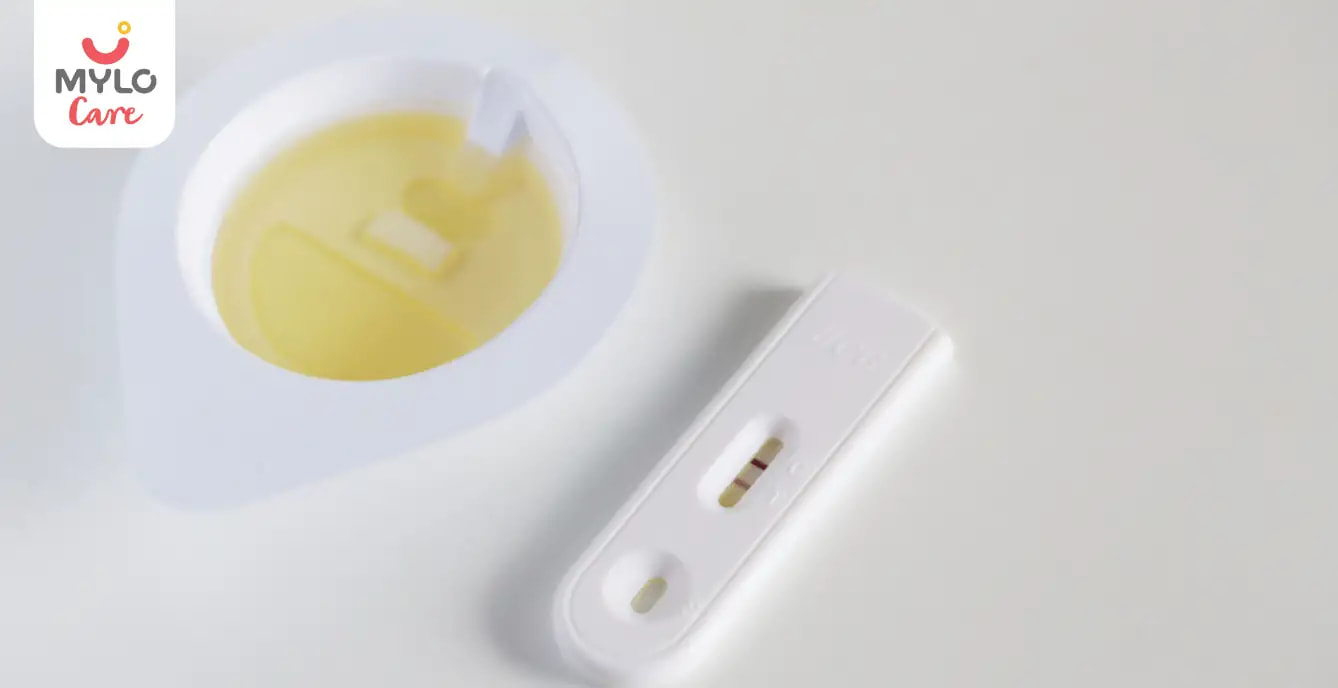Home

Pregnancy Tests

Urine Pregnancy Test: A Step-by-Step Guide for Every Woman
In this Article

Pregnancy Tests
Urine Pregnancy Test: A Step-by-Step Guide for Every Woman
Updated on 27 February 2024
In the journey of motherhood, the first step often begins with a simple urine pregnancy test. If you too are beginning your journey to pregnancy and are feeling overwhelmed with pregnancy tests, their procedure and results, then this article is for you. This article provides a clear and concise step-by-step guide for women, ensuring they have the necessary information to navigate this pivotal moment with confidence and understanding.
Is urine test for pregnancy accurate?
Urine tests for pregnancy are a popular and convenient method for women to determine if they are pregnant. These tests work by detecting the presence of human chorionic gonadotropin, (HCG) a hormone produced during pregnancy, in a woman's urine. While urine test for pregnancy is generally accurate, it is important to understand its limitations and how to properly interpret the results.
It is crucial to follow the instructions provided with the test kit carefully to ensure accurate results. Factors such as the sensitivity of the test, the timing of the test, and the concentration of hCG in the urine can all affect the accuracy of the test. It is recommended to wait until at least a week after a missed period to take a urine test, as this allows ample time for hCG levels to rise and be detectable in the urine.
Step-by-step guide to doing a urine pregnancy test
Performing a urine test is a simple process that can be done in the comfort of your own home. Here is a step-by-step guide to help you navigate through the process:
1. Read the instructions
Carefully read the instructions provided with the test kit before starting the test. Each brand may have slightly different instructions, so it is important to familiarize yourself with the specific requirements of the test you are using.
2. Collect urine sample
Collect a urine sample in a clean and dry container. It is recommended to use the midstream urine, meaning you should start urinating briefly before collecting the sample. This helps to ensure that any contaminants are flushed out before collecting the sample.
3. Perform the test
Depending on the type of test kit you are using, you may need to dip a test strip into the urine sample or use a dropper to place a few drops of urine onto a test cassette. Follow the instructions provided to complete the test correctly.
4. Wait for the results
After performing the test, you will need to wait for a specific amount of time, usually a few minutes, for the results to appear. It is important to adhere to the recommended waiting time as reading the test too early or too late can lead to inaccurate results.
5. Interpret the results
Once the waiting time has elapsed, observe the test for any visible changes. Most urine pregnancy tests will display either a positive or negative result. A positive result typically shows two lines or a plus sign, indicating the presence of hCG, while a negative result shows only one line or a minus sign, indicating the absence of hCG.
You may also like: What to Do When You Get an Invalid Pregnancy Test?
How long to hold urine for pregnancy test?
The length of time you should hold your urine before taking a pregnancy test can vary depending on the sensitivity of the test and the concentration of hCG in your urine. It is generally recommended to hold your urine for at least four hours before taking a pregnancy test to ensure that the hCG levels are detectable.
Holding your urine for an extended period, such as overnight, may lead to more concentrated levels of hCG in the urine, potentially increasing the accuracy of the test. However, it is important to note that excessively long holding times, such as more than eight hours, can dilute the urine and make it more challenging to detect hCG accurately.
If you are unable to hold your urine for an extended period, consider using a first-morning urine sample for your pregnancy test. The first-morning urine is typically more concentrated, as it has had a longer time to accumulate hCG overnight. This can increase the accuracy of the test, even with a shorter holding time.
How long to hold urine for afternoon pregnancy test?
If you prefer to take a pregnancy test in the afternoon, it is still recommended to hold your urine for a few hours before testing. Holding your urine for at least two to four hours can help ensure that the hCG levels in your urine are detectable.
Although the afternoon urine may be less concentrated than the first-morning urine, holding your urine for a few hours can help increase the accuracy of the test. Remember to follow the instructions provided with your test kit for the optimal holding time specific to the brand you are using.
You may also like: What are the Causes & Symptoms of a False Pregnancy?
How many drops of urine in pregnancy test are required?
The number of drops of urine required for a pregnancy test can vary depending on the specific test kit being used. Some kits may require only a few drops, while others may require a larger volume of urine. It is crucial to read and follow the instructions provided with the test kit to determine the exact number of drops required.
Typically, test kits will come with a dropper or a strip that needs to be dipped into the urine sample. The instructions will specify the required number of drops or the depth to which the strip should be dipped. Ensure that you follow these instructions precisely to obtain accurate results.
You may also like: How to Use Pregnancy Strip Test
Is it necessary to use first urine for pregnancy test?
Using the first urine of the day is not always necessary for a pregnancy test, but it can increase the accuracy of the results. The first-morning urine is more concentrated due to the longer period of time between urination during sleep, allowing for higher levels of hCG to accumulate.
If you choose to use the first-morning urine, it is recommended to hold your urine overnight and use the urine collected in the morning for the test. However, if you are unable to use the first-morning urine, holding your urine for at least a few hours before testing can still yield accurate results.
Pregnancy urine test results explained
When performing a urine test for pregnancy, there are typically two types of results that you can obtain:
1. Positive
A positive result indicates the presence of hCG in your urine, which is a strong indicator of pregnancy. Most urine pregnancy tests will display a positive result as two lines or a plus sign. It is important to note that even a faint line or a light plus sign still indicates a positive result. If you receive a positive result, it is advisable to consult with a healthcare professional for further confirmation and guidance.
2. Negative
A negative result, on the other hand, indicates the absence of hCG in your urine and suggests that you are not pregnant. A negative result is typically displayed as a single line or a minus sign. It is important to remember that a negative result may not be entirely accurate if the test is taken too early in the pregnancy. It is recommended to retest after a few days or consult with a healthcare professional if you suspect you may be pregnant despite a negative result.
Key Takeaways
Urine pregnancy test is generally accurate but must be performed correctly and interpreted as instructed. Follow the step-by-step guide provided with the test kit to ensure accurate results. Positive results indicate pregnancy, while negative results suggest no pregnancy. Seek professional guidance for further confirmation if needed. Remember, if you suspect you may be pregnant, it is always advisable to consult with a healthcare professional for confirmation and guidance.
References
1. DeLaney M, Wood L. (Sep 2018). Urine pregnancy testing: When does no mean maybe? J Am Coll Emerg Physicians Open.
2. Betz D, Fane K. Human Chorionic Gonadotropin. (2023 Aug). In StatPearls [Internet]. Treasure Island (FL): StatPearls Publishing; 2024 Jan
3. Gnoth C, Johnson S. (2014 Jul). Strips of Hope: Accuracy of Home Pregnancy Tests and New Developments. Geburtshilfe Frauenheilkd
4. Chard T. (1992May). Pregnancy tests: a review. Hum Reprod.



Written by
Anandita Sharma
Drawing on more than a decade of expertise in administration, Anandita Sharma currently serves as a content operations e
Read MoreGet baby's diet chart, and growth tips

Related Articles
Related Questions
Hello frnds..still no pain...doctor said head fix nhi hua hai..bt vagina me pain hai aur back pain bhi... anyone having same issues??

Kon kon c chije aisi hai jo pregnancy mei gas acidity jalan karti hain... Koi btayega plz bcz mujhe aksar khane ke baad hi samagh aata hai ki is chij se gas acidity jalan ho gyi hai. Please share your knowledge

I am 13 week pregnancy. Anyone having Storione-xt tablet. It better to have morning or night ???

Hlo to be moms....i hv a query...in my 9.5 wk i feel body joint pain like in ankle, knee, wrist, shoulder, toes....pain intensity is high...i cnt sleep....what should i do pls help....cn i cosult my doc.

Influenza and boostrix injection kisiko laga hai kya 8 month pregnancy me and q lagta hai ye plz reply me

RECENTLY PUBLISHED ARTICLES
our most recent articles
Sudden Infant Death Syndrome
Sudden Infant Death Syndrome (SIDS): Meaning, Causes & Prevention

Periods
Period After Abortion: What to Expect About Timing, Duration and Frequency
Daily Care Tips
Thumb Sucking: How to Help Your Child Break the Habit

Women Specific Issues
The Ultimate Guide on How to Shrink Ovarian Cysts Naturally

Conception
Ashwagandha Benefits for Female & Male Fertility: How This Ancient Herb Can Help You Conceive

Swaddling
What are the 12 things that parents can do with their baby in the first 12 months?
- The Lowdown on Cetirizine in Pregnancy: A Must-Read for Expecting Moms
- The Ultimate Collection of Paheliyan with Answer for Kids
- The Ultimate Guide to Abdominal Pain After Abortion Causes and Care
- Ovulation Kit 101: A Beginner's Guide to Tracking Fertility & Maximizing Your Chances of Conception
- Is Breast Pain after Abortion Normal? What You Need to Know
- Twin Pregnancy: Signs, Types & Risks
- Chasteberry Benefits: The Natural Remedy You Need for Infertility, Hormonal Imbalance, and PMS
- The Ultimate Guide to Planning the Perfect Baby Shower
- 50+ New Born Baby Wishes to Congratulate New Parents
- First Period After C Section: How Long Does It Last
- Introducing Solid Foods to your 6-month-old Baby? Here is a complete Food Chart along with some Nutritious Recipes
- What to expect about the height/length of 6 months old?
- The Development of Your Kid at the Age of Four Months
- Burping Your Baby


AWARDS AND RECOGNITION

Mylo wins Forbes D2C Disruptor award

Mylo wins The Economic Times Promising Brands 2022
AS SEEN IN
















- Mylo Care: Effective and science-backed personal care and wellness solutions for a joyful you.
- Mylo Baby: Science-backed, gentle and effective personal care & hygiene range for your little one.
- Mylo Community: Trusted and empathetic community of 10mn+ parents and experts.
Product Categories
baby carrier | baby soap | baby wipes | stretch marks cream | baby cream | baby shampoo | baby massage oil | baby hair oil | stretch marks oil | baby body wash | baby powder | baby lotion | diaper rash cream | newborn diapers | teether | baby kajal | baby diapers | cloth diapers |








